Summer lawn care guide
3 août 2023 Landscaping & Turfcare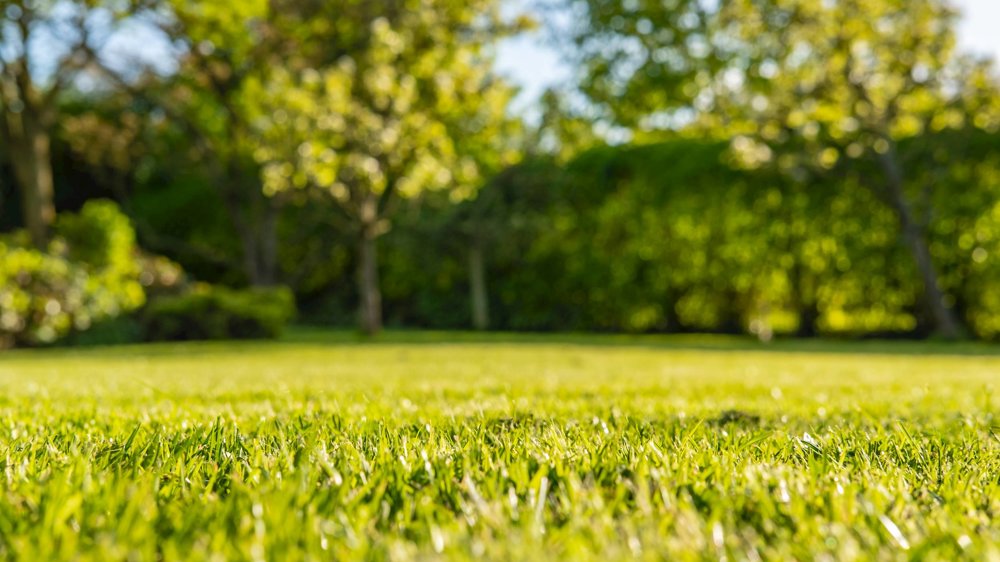
Summer is a busy time for any professional landscaper. Increased heat and sunlight make for optimum growing conditions for plants and lawns that need managing, and with clients spending more time outdoors there's often increased demand for landscaping services.
But summer can also see the onset of drought.
Over the past few years, we've seen a trend across Europe for increased heatwaves and, as a result, drought conditions are becoming the new normal during the summer months. In 2023 and 2024, this will likely be exacerbated by the El Niño weather phenomenon; already, we are seeing temperatures across Europe soaring to well over 40 degrees Celsius.
The likelihood of drought may require you to change your usual summer lawn care regimen. From mowing to watering to maintenance between seasons, we share advice for those wanting a quick refresh on keeping grass green this summer.
Dealing with drought
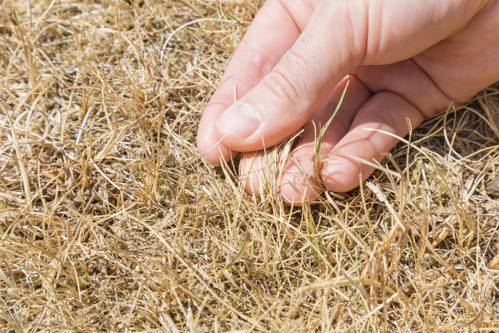
One of the largest battles a landscaper might face with their lawn during the summer months is drought. It can leave once pristine lawns looking yellow and leave grass susceptible to disease later down the line.
While the exceptionally high temperatures Europe is currently experiencing – with some areas seeing temperatures over 45 degrees Celsius – is a key contributor to drought, most domestic lawns are hardy enough to withstand a heat wave. It's what lies beneath that is important in maintaining a healthy lawn.
Managing the moisture of the root zone is of utmost importance in keeping your clients’ lawn healthy. A damaged root zone can hinder the roots' ability to retrieve and hold water during a heat wave, making it difficult to recover dead-looking grass when the rain returns in the autumn.
You can assess the moisture level of grass by examining the top two or three inches. If grass begins to look dull, holds onto footprints without springing back or growth is slow then the lawn could be in danger of drought. Opening the soil to a two or three-inch depth will also allow you to observe if the soil is moist or dry.
Mowing
Hot weather can be as stressful on the ground as it can be for the landscapers maintaining the lawns. Preserving moisture, preventing evaporation and causing as little damage to the grass as possible should be at the top of the agenda.
Grass is made up of 85 percent water which means that moisture is literally cut away with every inch. As well as this, cutting a lawn regularly promotes growth. When resources such as water are limited, this growth can use up valuable moisture so it's best to avoid cutting too often.
Landscapers might want to avoid cutting lawns altogether and stressing the grass or causing it further damage. Longer grass also creates self-shade, helping to protect the plant for longer. Instead, you may turn your attention to other services such as hard landscaping or hedge cutting while you wait for the weather to cool and ground to recover.
With that being said, with considered and altered mowing patterns that account for potentially fragile lawns, grass can still be mowed in hot and dry conditions if necessary. Many landscapers will employ the one-third rule when cutting grass in the summer. This means never removing more than one-third of the grass leaf in any one cut so that moisture can be retained.
During drought, typically landscapers might aim to cut grass on ornamental lawns down to around 10-15mm while more hard-wearing domestic lawns often see a height of 25-40mm.
The best machines for the job
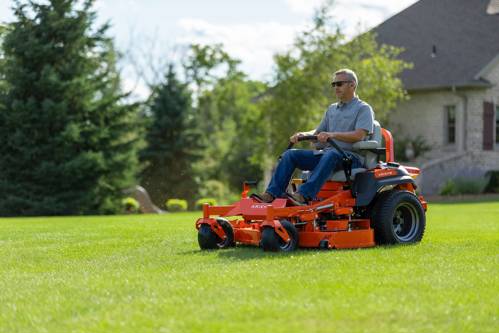
For professional landscapers working on extensive landscapes such as parks or sports fields, efficiency is a priority. This is even more true in times of drought when landscapers may want to cover large areas quickly to minimise overall mowing time and the stress the cutting process causes to grass in dry periods. The solution: a zero-turn mower, known for both its manoeuvrability and speed.
Compared to traditional mowers, zero-turn mowers also distribute the weight of the machine more evenly due to their wide tires and low ground pressure. This helps minimise soil compaction, which is crucial during a drought when the soil is already dry and vulnerable. Reduced soil compaction allows the soil to retain moisture better and promotes healthier root growth.
If a zero-turn mower isn’t in your tool kit, or you’re working on a smaller area of land, rotary mowers are recommended for use on parched grass as they have one very high-speed rotating blade underneath that will ‘chop’ the blades of grass on impact, leaving it longer – unlike a cylinder mower’s scissoring motion which offers a closer cut. They come in the form of walk-behind and ride-on models and with sufficient power and sharp blades, a rotary mower will provide a clean cut that will prevent excessive water loss during the process.
It's all in the blade
Even with the best mower on the market, a dull blade can cause unnecessary trauma to a lawn, something that should be avoided at all costs when in a drought. Instead of cleanly cutting blades of grass, a dull blade will tear or rip them, causing stress to the lawn.
Ragged cuts not only increase moisture loss, they provide entry points for pathogens, increasing the chance of infections in the grass and allowing weeds to flourish in weak areas.
It’s a good idea for professional landscapers to regularly inspect and sharpen their blades, clean the mower deck and follow the manufacturer's recommendations for maintenance in order to achieve the best cuts and maintain the healthiest lawns during a drought.
Leave grass longer
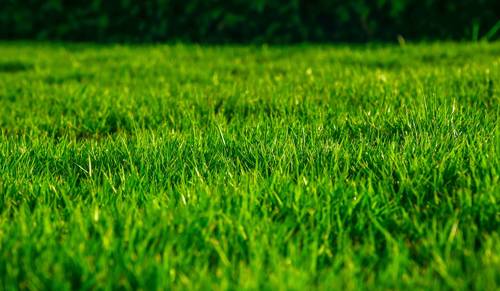
Preventing moisture loss isn't the only benefit of leaving longer intervals between cutting cycles and letting grass grow in length. A longer cut, made easier through the use of a rotary mower creates a barrier between the soil and the drying effects of the weather, creating a natural shade that will keep the ground beneath cooler. In turn this will allow the soil to hold onto water for longer and prevent the evaporation that can worsen drought conditions.
Another benefit of letting your clients’ grass grow longer is that it is better able to trap morning dew, which can work wonders in providing the ground with a much-needed drink.
When the time to mow does come about, adjust your mower blade to raise cutting by approximately three inches to allow for this extra length.
Keep your clippings
In the same vein as letting your clients’ grass grow longer to provide shelter for the soil, leaving grass clippings on the lawn after it's cut will also provide a barrier from the sun and prevent evaporation. If your mower allows you to cut with the box off, leave the finer-than-usual clippings to sit on the grass. They'll act as mulch and transfer precious moisture back into the ground and will usually disappear altogether within 24 hours. Just make sure they're small enough to avoid smothering the lawn.
While you may advise this technique in the name of keeping your clients’ grass and soil healthy through drought conditions, leaving grass clippings on the lawn may not be practical for every client especially if they have garden events planned or own pets. Speak to your client about the benefits of leaving clippings on the lawn and see how they would like to proceed.
Embrace the wild
Even with the best preventative care, drought conditions can leave lawns looking weathered. You may consider forming a plan with your clients to change up their existing lawns to include drought resistant plants such as perennials around their borders. They will not only break up a browning landscape, they can also help to repair grounds in the long run.
Wildflowers create a microclimate that helps to reduce evaporation and water loss, and their extensive root systems support the soil beneath the lawn's surface to prevent erosion and minimise the compaction that may come with increased foot traffic.
Perennials grow naturally in the spring and a less frequent cutting pattern will encourage more growth, but landscapers can also take further action by mulching flowerbeds. If done in the early spring just as the perennials are beginning to grow, they won't require any extra water – a benefit with heat waves on the horizon.
Lawn weeds and moss
In drought conditions where water may already be sparse, the last thing your clients’ lawns need is to compete for these precious resources with weeds and moss. Minimising lawn weeds during drought can help conserve water resources. There are a number of different methods a landscaper may go about weed control, including:
- Applying a layer of organic mulch such as straw or wood chips around plants in garden beds to suppress weed growth by blocking sunlight and conserving soil moisture.
- Removing the weed as soon as it appears to prevent regrowth by hoeing.
- Using a targeted herbicide to manage persistent or widespread weeds while minimising impact on desirable plants, or using vinegar-based spot treatments as a natural alternative.
- Using pre-emergent herbicides to prevent weeds before they can germinate.
- Minimising soil cultivation and disturbance during drought conditions as it can lead to increased water loss and weed germination.
Educate clients on proper lawn care maintenance
You can employ all the best techniques when managing your clients' lawns during drought, but without proper maintenance between servicing, lawns can still succumb to damage. Consider delivering clients some summer lawn care advice to carry out between servicing so that lawns can be given the best fighting chance possible.
Let them know that they should avoid excessive foot traffic on their lawns, especially in areas that are heat damaged. They should also carry out regular removal of debris such as fallen leaves and excess grass clippings to prevent the development of disease.
Watering in a heat wave
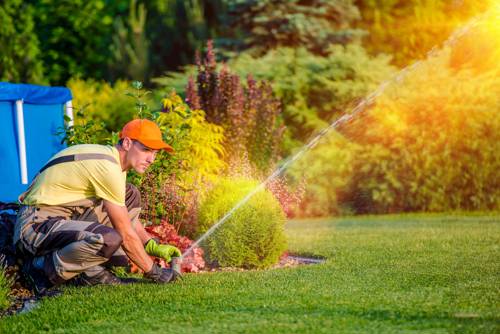
Watering is a key aspect of summer lawn care, especially when dealing with extreme temperatures and the possibility of drought. It’s also something that can largely be out of a landscaper’s control, with the responsibility on your client to manage their watering schedule.
Pass on the below advice to optimise their watering and maintain the health of their lawn in both the short and long term.
When the ground is looking dry it can be tempting to soak the ground with moisture as soon as the water supply allows. However, the trick is to water deeply and infrequently so as not to cause further damage to their lawn.
If your clients water too shallow they're at risk of only penetrating the top layer of soil, and as a result encourage roots to grow nearer the surface where they're much more vulnerable to drying out – something that is much harder to fix than dry soil. Advise clients to water a patch of lawn for a maximum of an hour at a time to ensure it can reach the base of the root.
It's recommended to water early in the morning or in the evening when the sun is not at its peak to prevent the water from evaporating before it has a chance to sink down to the roots.
They should also be reminded that during drought, it's important to adhere to any local regulations, guidelines and best practices in relation to water usage during drought conditions. Make sure they keep informed on current guidelines as they may change frequently and between regions.
Preventing next year’s drought
Prevention is better than a cure when it comes to drought, and aeration is one of the key preventative measures a landscaper might take by giving roots access to necessary nutrients year-round.
In hot weather ground surface becomes dry and hard which makes it difficult for water to permeate down to the root. By punching holes into the soil through dedicated aeration machines, or even through spiking with a garden fork, water and oxygen is able to filter down to the roots, allowing them to hold onto water for longer in the event of a drought.
Loosening compacted soil and reducing soil density, aeration provides better oxygen exchange in the root zone. Healthy and robust root systems are more efficient in extracting water from the soil, making them better equipped to withstand drought conditions. Increased root growth also enhances the grass's ability to access deeper water reserves.
It's best to aerate before drought strikes and the ground gets too hard. Aerating in the middle of a drought can actually have adverse affects on the health of your clients’ lawn as it will increase water evaporation from the soil.
Spring is the optimum time to aerate as the ground is dry enough to prevent the holes from sealing up and allows for faster recovery and optimal root development during the peak growing season. Alternatively, aerating in autumn when the soil is still warm, allows for good root growth, and increased rains help the grass recover quickly after aeration.
Make the most of your summer lawn care
Weather patterns may be changing across Europe and landscape practices along with it, but one thing will always remain the same: the need for high-quality, reliable machinery. Making sure you have the best tools for the job can make your life easier when dealing with even the most difficult of conditions. A well-informed lawn care schedule paired with a Powered by Kawasaki machine will ensure the lawns in your care can survive drought and flourish again in the spring.
You may be interested in
-
Espaces verts emblématiques d’Europe

-
Scarification des pelouses : à quelle période et comment raviver la repousse ?

-
Quels sont les pays européens les plus verts ?

-
Comment rendre une pelouse insensible aux intempéries et la protéger contre les inondations, le gel et la sécheresse

-
Landscaping trends for 2024

-
Entretien des espaces verts : avez-vous déjà cru à l’un de ces mythes ?







